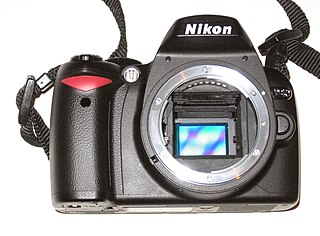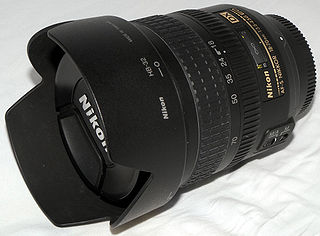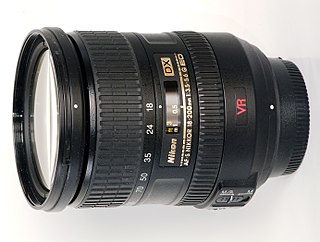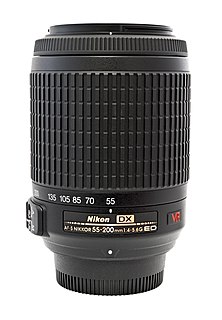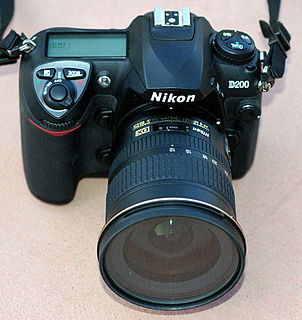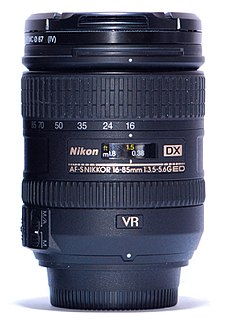| Maker | Nikon |
|---|---|
| Technical data | |
| Type | Zoom |
| Focal length | 10-100 mm |
| Crop factor | 2.7 |
| Aperture (max/min) | f/4.5-16 |
| Close focus distance | 0.3-0.85 m |
| Max. magnification | 1:2.9 |
| Diaphragm blades | 7 (rounded) |
| Construction | 21 elements in 14 groups |
| Features | |
| Ultrasonic motor | |
| Lens-based stabilization | |
| Macro capable | |
| Application | Superzoom |
| Physical | |
| Weight | 515g |
| Filter diameter | 72 mm |
| History | |
| Introduction | September 2011 |

The Nikon 1 Nikkor VR 10-100 mm f/4.5-5.6 PD-Zoom for the 1 series' unique CX format (crop factor 2.7) is a Superzoom lens manufactured by Nikon, introduced in September 2011 for use on Nikon CX format mirrorless interchangeable-lens cameras.

The Nikon 1 series was a high-speed mirrorless interchangeable-lens cameras with 60 frames per second (fps) continuous shooting speed, using Nikon 1-mount lenses and announced on 21 September 2011. The series currently includes Nikon 1 V1, J1, J2, and S1 with a 10-megapixel image sensor, the V2, J3, S2 and AW1 with a 14-megapixel image sensor and further increased autofocus speed to 15 frames per second (fps), and the 1 V3, J4 with a new 18-megapixel image sensor, further increased — again world’s fastest — autofocus speed to 20 fps, 120 fps HD slow-motion at 1280 x 720 and 1080/60p. The J5 model added a 20.8MP sensor in 2015 and kept most other technical specifications the same as the J4 model.

In digital photography, the crop factor, format factor or focal length multiplier of an image sensor format is the ratio of the dimensions of a camera's imaging area compared to a reference format; most often, this term is applied to digital cameras, relative to 35 mm film format as a reference. In the case of digital cameras, the imaging device would be a digital sensor. The most commonly used definition of crop factor is the ratio of a 35 mm frame's diagonal (43.3 mm) to the diagonal of the image sensor in question; that is, CF=diag35mm / diagsensor. Given the same 3:2 aspect ratio as 35mm's 36 mm × 24 mm area, this is equivalent to the ratio of heights or ratio of widths; the ratio of sensor areas is the square of the crop factor.
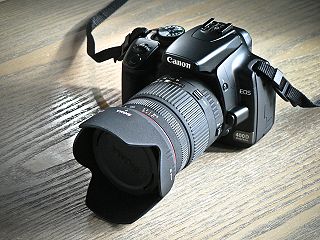
A superzoom or hyperzoom lens is a type of photographic zoom lenses with unconventionally large focal length factors, typically ranging from wide angle to extreme long lens focal lengths in one lens. There is no clear definition of a superzoom lens but the name generally covers lenses that have a range well above the 3x or 4x of a standard zoom lens, with lenses being 10x, 12x, 18x, or above considered superzoom.
Contents
It integrates a high amount of technologies: 21 elements in 14 groups including 1 High Refractive Index (HRI), 3 Extra-low Dispersion (ED) and 2 aspherical lenses, [1] Super Integrated Coating (SIC), internal focusing (IF) with world's fastest quiet ultra-fast Voice Coil motor (VCM), silent 3-speed PD-Zoom, Vibration Reduction (VR II), retractable lens mechanism and 7 rounded diaphragm blades. [2] [3]

A voice coil is the coil of wire attached to the apex of a loudspeaker cone. It provides the motive force to the cone by the reaction of a magnetic field to the current passing through it. The term is also used for voice coil linear motors, such as those used to move the heads inside hard disk drives, which produce a larger force and move a longer distance but work on the same principle.
Together with the Canon EF 28-300mm lens it is the only current superzoom with 20 elements or more. There's no distance scale and it doesn't feature an aperture ring.



